Library of Congress's Blog, page 140
October 22, 2015
10 Stories: Look to the Skies! Chronicling America
In celebration of the release of the 10 millionth page of Chronicling America, our free, online searchable database of historical U.S. newspapers, the reference librarians in our Serials & Government Publications Division have selected some interesting subjects and articles from the archives. We’ll be sharing them in a series of Throwback Thursday #TBT blog posts during the next few weeks.
Today we return to our historical newspaper archives for reports of endeavors and antics in the air, mostly through powered, heavier-than-air machines. But sometimes a person just has to get shot out of a cannon.
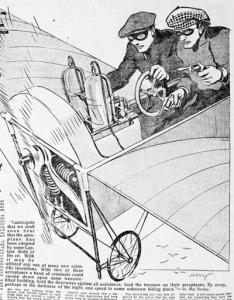
Sky Pirates! From the Salt Lake Tribune, May 12, 1912.
“Ohio Boys Who Have Invented a Flying Machine Which Flies”
It all started with Orville and Wilbur Wright. And before you mock the redundancy in the headline, please note that in those days, not all flying machines actually got off the ground. Tacoma (Washington) Times, Dec. 26, 1903.
“Startling Feat Crowns Trip of Aviator Atwood”
Pilot lands his plane on the White House lawn. Gets a medal and hearty handshake from President Taft. Does not get taken into custody. These were simpler times. Washington Herald, July 15, 1911.
“Aviator Sees Sporting Chance to Reach Roof of World”
While he was a long-lived aviator (d. 1974) known for his air speed records, we are not certain that Roland Rohlfs ever made it to Mount Everest. Odgen (Utah) Standard-Examiner, Jan. 17, 1921.
”Will It Be the Aeroplane Pirates Next?”
A spate of murders and robberies by three “automobile pirates in Paris” leads a “great German scientist” to the obvious next step: sky pirates. Salt Lake Tribune, May 12, 1912.
“100-Foot Drop, Nearly Drowned; About Cured Her of Air Game”
“It isn’t often that a woman falls 100 feet, while strapped to the seat of an aeroplane, plunges into the ocean and after being held under the water for three minutes, is rescued and lives the tell the tale.” No, not often at all. Mrs. Florence Seidell had just learned to fly a few weeks back, too, according to the Chicago Day Book, Sept. 25, 1913.
“Airplane Acrobatics”
It’s the “very newest sport,” said the New York Tribune of April 20, 1919, but not for the faint of heart.
“Things You Might Have to Do If You Acted in Motion Pictures”
Including dangerous (and even fatal) stunts from airplanes, recounted in the Washington Evening Star, July 25, 1915.
“Marooned 50 Hours on a Skyscraper”
Not a pilot, but an unintentional denizen of the sky: A brave clerk leaps to save an important paper when the window closes behind him. Passers-by point and laugh. A typical day in New York City, as reported in the Rising Son (Kansas City, Mo.), May 18. 1907.
”Hazardous Feats the Thrill the Blood”
Just a little before powered flight began, such feats might include an “aeronaut” taking to the sky via balloon and jumping out with a parachute. Whew! San Francisco Call, July 13, 1902.
Bonus Story: “100 Ways of Breaking Your Neck”
In somewhat the same vein and with all of the perilous activity mentioned this week, it was hard for us to leave off this delightful piece from the Omaha (Nebraska) Daily Bee, April 16, 1905. To be fair, they only list six waysbut two of those entail being shot into the air (albeit without aeroplane or balloon).
Launched by the Library of Congress and the National Endowment for the Humanities (NEH) in 2007, Chronicling America provides enhanced and permanent access to historically significant newspapers published in the United States between 1836 and 1922. It is part of the National Digital Newspaper Program (NDNP), a joint effort between the two agencies and partners in 40 states and territories. Start exploring the first draft of history today at chroniclingamerica.loc.gov and help us celebrate on Twitter and Facebook by sharing your findings and using the hashtags #ChronAm #10Million.
October 21, 2015
The Future is Now
Jumping gigawatts! Today, the future has arrived! If you were around in 1989, Oct. 21, 2015, may have seemed light-years away, and you might have thought we would all be riding around in flying cars or something. Well, your imagination isnt as far-fetched as you think.
On this day, Marty McFly jumped through time to arrive in the future Oct. 21, 2015, to be exact in the film Back to the Future II (1989) to save his future son from going to prison. While fixing one thing, McFly and trusted friend Doc Brown create numerous other problems in this zany sci-fi adventure that has become a cult classic, along with the other two movies in the trilogy.
What really stands out are the fantastical predictions the movie made for a point in time some 25 years later. And, some have actually since come true. While we dont yet have flying cars, self-lacing shoes or Jaws 19, and fax machines are actually becoming a passé technology, we do have such advancements as video phones, flat screen and smart TVs, virtual-reality goggles, holograms and fingerprint technology and voice control systems and software. And, yes, people still do drink Pepsi.
And, while Back to the Future II predicted the Chicago Cubs would win the 2015 MLB World Series, the baseball team is currently in the playoffs, so thats something, right?

Futuristic air travel. Drawing by Harry Grant Dart. Between 1900 and 1910. Prints and Photographs Division.
Recently, the movie had me thinking about other predictions and inventions that were ahead of their time, so I mined the Librarys collections for historical examples of future advancements.
The dream of human flight was made a reality thanks to the Wright brothers invention of the first powered heavier-than-air flying machine in 1903. However plenty of others before and after the noted duo had their own ideas of what flight would look like all of which are a far cry from todays airplanes.
This 1882 lithograph by French artist even depicts aircraft in the form of buses, limousines and police patrol cars. Perhaps Back To The Future II wasnt completely ahead of its time.
Robida produced a trilogy of books with a futuristic outlook, and his imagined social developments ended up being quite accurate: feminism, mass tourism and pollution, among others. His writings describe modern warfare, including robotic missiles and poison gas. And his future world revolves around the téléphonoscope, a flat screen television display that delivered the latest news and entertainment 24-hours a day,
A common theme among futuristic predictions is architecture. The Librarys collections contain several examples.
This rendering of a 150-story office building, sketched by Cass Gilbert in 1905, was truly a vision of a century later. The current tallest building in the world is the Burj Khalifa, built in 2010 in Dubai, at 163 floors.
Other images foreshadow tall skyscrapers and highways, display a house of the future, advertise a $15,000,000 residential and shopping development in Washington, D.C. designed by Frank Lloyd Wright and highlight spaceship-looking buildings in Texas.

“Starship Pegasus,” a failed futuristic restaurant and gift shop in in Italy, Texas. Photo by Carol M. Highsmith, Sept. 9, 2014. Prints and Photographs Division.
As far as technology, we have since seen three-dimensional films, color televisions and phone booths.
Another good resource of futuristic imagery is the Librarys collection of worlds fair imagery, which often featured state-of-the-art science and technology from around the world.
While Back to the Future II was a source for future contemplations, what other films have made assumptions that came to fruition?
Sources: A Stereoscopic Vision of the Future: Albert Robida’s Twentieth Century, by Philippe Willems
October 16, 2015
Lewis Helps Library Celebrate Acquisition of Personal Papers
(The following was written by Mark Hartsell, editor of the Library’s staff newsletter, The Gazette.)

Jerry Lewis laughs with (from left) Rob Stone, son Chris Lewis and John Snelson. Photo by Shawn Miller.
Jerry Lewis sat alone in the spotlight, reflecting on his career and on the passage of the years for both him and the fans who filled the historic State Theatre.
At the time that I began, which was some time ago, I was playing to this audience, the 89-year-old Lewis said. This audience who were 10, 11, 12 that was the age of most of my audience when I first began. Its such a good feeling to see that audience again 40 or 45 years later.
So when I look at you and I smile, its because I remember you all so well.
The Library of Congress in September acquired the legendary comedians personal collection: films, documents, test footage, outtakes, home movies and photos that collectively chronicle more than seven decades of laughter.
Lewis spent Oct. 9 helping the Library celebrate the occasion, performing a sold-out show that night before raucous fans in the State Theatre on Main Street in Culpeper, Virginia.
Lewis began by thanking the Library for its work in preserving his collection.
I was at the Library of Congress today. Most fantastic experience Ive ever had in my life. To think I had to come to Culpeper thats with one p, he quipped. Its just an incredible facility, and anyone thats got it would be very proud. Im sure that Culpeper is as proud as they could get because they know well that its not something you put together in a week.
Im so happy theyve taken all of my work, all of my films, and theyre working on them. And theyre making them perfect.
Lewis then launched into a string of one-liners most of them politically incorrect interspersed with film clips covering all aspects of his career: scenes from his movies, a mock screen test he administered to comedian Milton Berle, performances onstage in Las Vegas with Sammy Davis Jr.
Lewis also showed his emotional, live-on-TV reunion with former partner Dean Martin at the 1976 Muscular Dystrophy Association telethon.
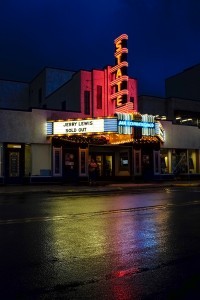
The historic State Theatre in Culpeper, where Jerry Lewis performed. Photo by Shawn Miller.
The Lewis and Martin comedy team had been one of Hollywoods hottest acts, but they split up in 1956 and didnt speak again until pal Frank Sinatra brought Martin onstage at the annual telethon two decades later.
That was an incredible night, Lewis remembered. My partner and I hadnt spoken to one another in 20 years. The stupidity of that I cannot in any way defend or acknowledge. … I am so grateful that we had that time together because this country loved those two guys and those two guys loved this country.
Earlier that day, Lewis toured the Librarys Packard Campus for Audio Visual Conservation in Culpeper.
Wearing black shoes bearing Greek masks of tragedy and comedy, Lewis examined historical film equipment, learned about preservation techniques, discussed his collection with processing technician John Snelson and examined the personal scrapbook of one of his comic heroes, Stan Laurel.
Guided by moving-image curator Rob Stone, Lewis explored the film vaults and viewed the original camera negatives of some historic films: The Great Train Robbery (1903), Edison Studios Frankenstein (1910) and A Plantation Act (1926), the first sound film made by another of Lewis heroes, Al Jolson.
I feel like I died and went to heaven, Lewis said.
The Packard staff also had a few surprises in store.
Lewis toured the Recorded Sound Section, where curator Matt Barton displayed, among other items, a tape of a Washington Senators baseball game that Lewis and announcer Bob Wolff called for a radio broadcast in 1957 a tape acquired by the Library two years ago as part of the Wolff sports broadcast collection.
They never recovered from that, he quipped about the sad-sack Senators. Lewis was presented with a CD of the broadcast.
Nitrate film specialist Larry Smith also had a special treat cued up: Three Hams on Rye, a Three Stooges comedy that featured Lewis father, Danny, in his first big-screen appearance a film Lewis said he hadnt seen since its release in 1950.
Lewis concluded his visit late that afternoon in the Packard Campus movie theater (Its gorgeous) with a question-and-answer session for Library staff members.
What a motley group you are, he said to laughter as he eyed the assembled group.
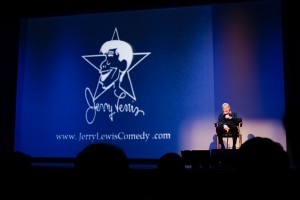
Jerry Lewis onstage at the State Theatre on Oct. 9. Photo by Shawn Miller.
For more than a half-hour, Lewis fielded questions and discussed his work with Martin (We had so much fun that it was ridiculous), the film that most inspired him (Captains Courageous), the night that Charlie Chaplin watched his act at the Olympia theater in Paris (I walked on air for four days), his first time on Broadway (I had a great time; I made a fortune), the dramatic role he most wanted to play (Auntie Mame, he quipped), and his proudest professional accomplishment (the Academy Award he received for his charitable work).
He closed by thanking the staff for its work to preserve his collections for future generations of film and comedy fans.
Im very grateful to you all for joining in the most fun Ive had in my life making the product that youre taking care of, Lewis said. It makes me very proud. …
When I pass away, I like to think that Ill be remembered. I know I will now, for sure. You think about that sometimes. Not often, but when you get close to 90 you think about it 90 is a hell of a number, aint it? … I do sincerely appreciate all of your help in taking care of the work that was my heart and soul.
October 15, 2015
10 Stories: Great Hair in History! Chronicling America
In celebration of the release of the 10 millionth page of Chronicling America, our free, online searchable database of historical U.S. newspapers, the reference librarians in our Serials & Government Publications Division have selected some interesting subjects and articles. We’ll be sharing them in a series of Throwback Thursday #TBT blog posts during the next few weeks.
Today we open our historical newspaper archives to review the subject of hair: its styling, care and (in the case of advertising) how to grow it.

“Miss J. Carroll, 2307 Irving Avenue, Chicago,” a happy Danderine user, from the (Ardmore, Okla.) Daily Ardmoreite, Oct. 4, 1907.
“Fashionable Coiffures for ’98”
From the San Francisco Call, Jan. 16, 1898: “Seven fashionable coiffures from which the American woman can take her choice,” illustrated.
“Dressing the Hair for Christmas Dinner”
Complete with fabulous illustrations and photos, courtesy of the St. Paul Globe, Dec. 28, 1902.
“How to Build the Spring Coiffure”
The San Francisco Call of April 6, 1902, devotes an entire page to managing the new “Low London Coiffures.”
“Demure Hair Dressing Is on the Way”
According to the Chicago Day Book (December 14, 1911), “elaborate head-dressing off-sets simple coiffures.”
“Fashions for January”
A national capital consumed by fears of Civil War needed a distraction: “…We mention the coiffure Gabrielle d’Estrees, of ponceau velvet, over which was rolled a thick gold cable chain, forming bows, with a bunch of elegant white feathers at the side,” reported “Le Follet” in the Washington Star, January 22, 1861.
“Hair of All Colors Except Orange…”
Stripes, checks, plaid, pale pink even polka dots! Chicago Day Book, Jan. 28, 1914.
“The Bowman Easter Hair Style Exhibit”
Not an April Fool gag but an ad for Bowman’s Hair Shop, from the (Harrisburg Pa.) Star-Independent, April 1, 1915.
“Danderine Grew Miss Carroll’s Hair and We Can PROVE IT!” (1907)
On to the hair tonics: a powerful hair-growth cure of the first decade of the last century took a full page ad in the (Ardmore, Okla.) Daily Ardmoreite, Oct. 4, 1907.
“Danderine Grew This Hair and We Can PROVE IT!” (1905)
They’re very emphatic about that. And to be fair, this is some pretty serious hair. Washington Evening Star, December 7, 1905.
“Ayer’s Hair Vigor”
“Do you think nature intended you should have short, stubby and thin hair?” Ayer’s special tonic will help you out. St. Louis Republic, Jan. 21, 1900.
Launched by the Library of Congress and the National Endowment for the Humanities (NEH) in 2007, Chronicling America provides enhanced and permanent access to historically significant newspapers published in the United States between 1836 and 1922. It is part of the National Digital Newspaper Program (NDNP), a joint effort between the two agencies and partners in 40 states and territories. Start exploring the first draft of history today at chroniclingamerica.loc.gov and help us celebrate on Twitter and Facebook by sharing your findings and using the hashtags #ChronAm #10Million.
October 14, 2015
Pics of the Week: #LibraryOpenHouse
The Library of Congress once again opened the doors to its magnificent Main Reading Room on Monday for a special open house, held twice each year. More than 6,100 visitors enjoyed the opportunity to learn about the Library’s services, resources and collections, speak with reference librarians and even go inside the decks to view the card catalog. Patrons included school groups from several states and family vacationers, both national and international.
A highlight of the open house was the opportunity to take pictures of the extraordinary art and architecture of the Main Reading Room and Thomas Jefferson Building. Library Instagram followers were encouraged to post their images using the hashtag #LibraryOpenHouse. We picked a few of our favorites to feature on this blog.

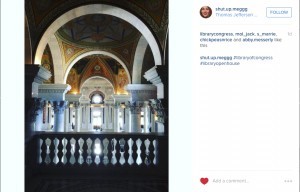

Make sure to follow us on Instagram to check out more pictures of the Main Reading Room open house and glimpses of life and work at the world’s largest library. You can also follow us on Facebook, Twitter, Pinterest, YouTube and iTunesU for even more access!
October 9, 2015
Library in the News: September 2015 Edition
In September, the Library of Congress had some big headlines from the announcements of new collections to celebrating the 15th annual National Book Festival and the inaugural reading of the new poet laureate.
The Library received a very special visitor and a very special book to add to its collections last month. During his tour of Washington, D.C., Pope Francis visited the Unites States Capitol. In his honor, the Library was given the Apostles Edition of The Saint Johns Bible, which was a gift from Saint Johns Abbey and University. The Bible is currently on view in the Librarys Jefferson Building though Jan. 2, 2016.
News outlets nationwide were covering the papal visit to the nations capital, including his stop at the Library.
The bible isnt particularly old or historically significant, wrote Allison Meier for hyperallergic.com. What the Saint Johns Bible represents is an effort to create artistic bibles in the mode of illuminated books of yesteryear, except reflecting present-day life and society.
This is some Bible, wrote Steve Kraske for The Kansas City Star. There are only 12 like it. Its 1,130 pages. It contains 160 illustrations. It measures 2 feet by 3 feet when open. And its the first handwritten Bible commissioned in more than 500 years.
The pope also has received an Apostles edition, but we have an entirely different copy, Mark Dimunation, chief of the Librarys Rare Book and Special Collections Division, told WTOP.
In September, the Library also acquired the papers of comedian Jerry Lewis.
The Daily Progress (VA) spoke with the Library Moving Image Curator Rob Stone.
Its unlike a lot of collections where you get somebodys films and theyre the films that everyone has seen and its great to have, but with this collection it goes much deeper because he sometimes turned on the camera just to turn it on, he said of Lewis collection. So the things you capture were really unique.
Also running stories were the Associated Press, Los Angeles Times, New York Times and the Washington Times.
The 15th annual National Book Festival received lots of news coverage.
NBC News highlighted the festivals Hispanic programming, calling it a vibrant Latino presence.
Optimism about the future of American storytelling was the mood of the day, even among traditional publishers, wrote Bridey Heing in her coverage of the festival for The Guardian.
Novelist Louise Erdrich was presented with the Library of Congress American Fiction Prize at the festival.
Im writing out of the mixture of cultures, said the mixed-race Native American author to her festival audience. Her presentation was also covered by The Guardian. Knowing both sides of my family really infused my life with a sense that I lived in many times and in many places as many people. It was never just me. I was always filled with the stories, the humor, the loss. Because, of course, we are all part of this great loss that occurred.
Other festival coverage came from CBS News, WTOP, Blogcritics, School Library Journal and Fine Books & Collections Magazine, among many others.
Juan Felipe Herrera, the nations new poet laureate, was also a featured presenter at the book festival. There, he launched his project, La Casa De Colores.
Herrera hopes La Casa de Colores will draw out diverse voices and experiences from across the U.S. to create a single, collaborative poem, wrote Kristian Wilson for bustle.com.
Herrera followed his festival debut with his Library debut a couple of weeks later, launching the Librarys literary season.
If there were any doubt, Herrera, the first Mexican American U.S. poet laureate, made it clear Tuesday night that hes bringing a new sense of wonder and drama to the position, wrote Ron Charles for The Washington Post. His inaugural reading was infused with humility and graciousness, but it was also an elaborately choreographed event informed by his years as a teacher and activist.
Along with Herreras expressive poetry readings about exiles, civil rights, immigration and unity, it was the corrido, a Mexican ballad, performed with Juan Díes from the Sones de Mexico Ensemble, about the death of Sandra Bland that filled the more than 300-member audience with emotion, said Grace Toohey for MClatchy News Service.
Herrera stopped by NPR before his lecture at the Library and read an excerpt from a poem he was writing for the evening.
October 8, 2015
10 Stories: Cat Tales! Chronicling America
In celebration of the release of the 10 millionth page of Chronicling America, our free, online searchable database of historical U.S. newspapers, the reference librarians in our Serials & Government Publications Division have selected some interesting subjects and articles. We’ll be sharing them in a series of Throwback Thursday #TBT blog posts during the next few weeks.
Today we not only celebrate our 10 millionth page of Chronicling America, but we honor the patron saint of the Internet, the humble feline. You think people are obsessed with cat videos today? Here are 10 high-profile newspaper stories concerning the not-so-common house cat.

From “In Praise of Cats,” illustration by Elizabeth F. Bonsall, Washington Evening Star, Sept. 15, 1907.
“Science Explains Why the Cat Comes Back”
Though not exactly like a homing pigeon, you may or may not rely on your cat to return, said the Washington Times on Oct. 1, 1922.
“Cat Saves Lives of Nine Sailors”
A hero cat leads the way to safety when a boat founders out of Firth of Fourth, Scotland, as reported the Klamath Falls (Ore.) Evening Herald of April 2, 1920.
“Shall We Kill Every Cat in U.S.?“
Horrors! But two sides got equal time in the Bisbee (Ariz.) Daily Review of Nov. 27, 1921.
“Your Cat Will Come Back in Furs“
An unpleasant speculation upon the fate of cats made homeless in the Great Earthquake and Fire of 1906, from the San Francisco Call of July 22, 1906.
“Cat Succeeds Monkey in New York Society”
A much finer fate awaited the urban felines highlighted in the Odgen City (Utah) Standard of Sept. 18, 1915. But the poor monkey!
“Pets of British Sailors on the H.M.S. Lenox”
Here the cat and the monkey lived together in harmony. “During the recent naval fight the cat stayed on deck, but the monkey hid in a fish kettle,” said the Washington Evening Star on Dec. 10, 1914.
“Ed Is a Highbrow Tabby”
Here at the Library we appreciate Ed, who enjoyed a good read, according to the Free Trader Journal and Ottawa (Ill.) Fair Dealer on June 16, 1922.
“Pacific Cat Exhibition Brings Out Handsome Felines”
The cartoonists got into the act with this comedic review in the San Francisco Call of August 31, 1900.
“Cat Traces Ancestry to Middle Ages”
An entry from the classic Chicago Day Book, July 4, 1912.
“In Praise of Cats”
Now we’re talking. Glowing prose from Agnes Repplier, sumptuous illustrations by Elizabeth F. Bonsall, in the Washington Evening Star of Sept. 15, 1907.
Launched by the Library of Congress and the National Endowment for the Humanities (NEH) in 2007, Chronicling America provides enhanced and permanent access to historically significant newspapers published in the United States between 1836 and 1922. It is part of the National Digital Newspaper Program (NDNP), a joint effort between the two agencies and partners in 40 states and territories. Start exploring the first draft of history today at chroniclingamerica.loc.gov and help us celebrate on Twitter and Facebook by sharing your findings and using the hashtags #ChronAm #10Million.
October 7, 2015
Going Inside the Library on Instagram
(The following is a post by Gayle Osterberg, director of communications for the Library of Congress.)
The visual richness of the Library of Congress never ceases to amaze me from the extraordinary architecture of its Thomas Jefferson Building, to the diverse public programs, to the collections themselves.
Many Americans will never have the opportunity to visit the Library in person, so we are always looking for ways to share the Library with them from digitized online collections to web videos of Library programs.
What better way to give people a snapshot of the institution than through a social media community devoted to images Instagram! It is a great way to provide a glimpse of contemporary life at the worlds largest library, from exhibitions to concerts, with the occasional historic image thrown in for good measure. Find us on Instagram at @librarycongress.
This Monday, the Library opens its Main Reading Room for our traditional Columbus Day Open House — a chance for individuals who arent researchers to come into the historic room, take pictures and learn a little more about how they can use the library themselves on a regular basis.
It is a great time to follow the Library on Instagram. If you havent been to our Main Reading Room, it is a feast for the eyes and the camera. Our own photographer, the very talented Shawn Miller, will be capturing and posting images.
It is also a great time to visit the Library and post your own photos using the hashtag #LibraryOpenHouse. Well pick three of our favorites from the day to feature on this blog next Wednesday.
Instagram is just the most recent way to connect with the Library on social media. We have accounts on Facebook, Twitter, Pinterest, YouTube and iTunesU all in an effort to throw open the doors even wider.
October 6, 2015
Rare Book of the Month: Agrippa Von Nettesheim and Things That Go Bump in the Night
(The following is a guest blog post written by Elizabeth Gettins, Library of Congress digital library specialist.)
Frontispiece portrait of Agrippa Von Nettesheim from “De Occulta Philosphia.” 1533. Rare Book and Special Collections Division.
Agrippa Von Nettesheim. Now that is a name with heft! This mouthful of a name is attached to a very interesting thinker who might be a good candidate for father of Halloween. He would fit right in with witches, black cats, tombstones, bats, ghouls, ghosts and things that go bump in the night. His lifelong passion, of all things, was the study of the occult.
Von Nettesheim, (1486-1535) wrote De Occulta Philosophia and a number of other works that address the supernatural and occult phenomenon. Published in Cologne in 1533, the work was considered to be the ultimate compendium of occult philosophy.
Using ideas from previous scholars to advance and formulate new and serious academic inquiry, Von Nettesheim joined the burgeoning Renaissance movement by melding concepts of science and magic in an to attempt to explain lifes mysteries. His ideas conflicted with the teachings of the church as they either brought up inconsistencies or introduced new explanations that were counter to Christian dogma. However, Von Nettesheim believed that one could arrive at Christ through the practice of magic and contemplation of philosophy. Essentially, one could understand the divine by practicing magic.
Born in Germany, Von Nettesheim was a jack of many studies, including theology, astrology, alchemy and magic. He was considered a controversial figure because he supported many radical thinkers of his time like Johannes Trithemius, who was a cryptographer and occultist. Not one to shy away from his convictions, Von Nettesheim publically espoused Trithemius doctrines and was accused of heretical thinking. However, he was shrewd enough to avoid serious persecution by not publishing De Occulta Philosphia for a number of years. Initially it was only available in manuscript form.
Illustration from “De Occulta Philosophia.” 1533. Rare Book and Special Collections Division.
Interestingly, Von Nettesheim appeared to recant his occultist beliefs later in his life. It is not known if this was a political maneuver he used to protect himself or if he had changed his ideas from his youth to a softer, more inclusive cannon of thought.
De Occulta Philosophia is just one work of many that the Rare Book and Special Collections Division holds on the topic of the occult and magic. The McManus-Young Collection and the Harry Houdini Collection offer seminal works and make the Library an important source for the study of magic. The McManus-Young Collection is particularly strong in publications and pictorial material relating to magic and magical apparatus, including works on conjuring, ventriloquism, fortune-telling, spiritualism, witchcraft, gambling, hypnotism, automata and mind reading. The Harry Houdini Collection includes publications, scrapbooks and other material relating to spiritualism and magic. In particular, the Houdini Collection contains a number of magic books inscribed or annotated by well-known magicians. Also in the collection are prints, playbills, printed ephemera, periodicals and many volumes of pamphlets on such topics as card tricks, mediums, hypnotism, handcuff escape methods and chalk-talking.

Harry Houdini. 1905. Rare Book and Special Collections Division.
The Rare Book and Special Collections Divisions digital page Materials on Science, Magic and Mathematics offers a broad view of samplings from early thought regarding the mechanisms behind the functioning of mans world around him to works on modern legerdemain (or sleight of hand). In the spirit of those that had the courage to explore and question the things that go bump in the night, take a scroll through this antiquated world of rudimentary science, old magic and the modern illusion!
Other Resources at the Library of Congress
Variety Stage: Digital collection that includes Harry Houdini
Magic Videos from the Motion Picture and Recorded Sound Division
Magic Posters Images from the Prints and Photograph Division
The Fantasy and Folklore of All Hallows: An essay from the American Folklife Center
Halloween in Chronicling of America: Articles from the Newspaper and Current Periodical Reading Room
A Ghostly Image: A blog post from the Prints and Photographs Division
Resources for Witchcraft at the Library of Congress: The John Davis Batchelder Collection and A Train of Disasters; Puritan Reaction to New England Crisis of 1680-90s
Other sources: Digitized works of Trithemius: Polygraphiae Libri Sex Ioannis Trithemij and Steganographia qvæ Hvcvsqve a Nemine Intellecta, both from the George Fabyan Collection
September 30, 2015
Books in Action: The Armed Services Editions
(The following is featured in the September/October 2015 issue of the Library of Congress Magazine, LCM. John Y. Cole, director of the Center for the Book in the Library of Congress, wrote the story. You can read the issue in its entirety here.)
When books went to war, many American soldiers and sailors discovered the joy of reading.
Between 1943 and 1947, nearly 123 million copies of flat, wide and easily pocketable paperbacks were distributed by Army and Navy Library Servicesfree of chargeto U.S. service members around the world.
How did this happen? In 1942, U.S. Army librarian Ray Trautman and Army graphic arts specialist H. Stahley Thompson approached a publisher with their idea to distribute inexpensive paperback editions overseas. They enlisted support from the Council on Books in Wartime, a nonprofit coalition of trade publishers, booksellers and librarians who viewed books as weapons in the war of ideas. The council turned a good idea from the U.S. Army into an efficient cooperative enterprise that involved the Army, the Navy, the War Production Board and more than 70 publishing firms.
Designed to appeal to a wide variety of reading tastes, the Armed Services Editions included best sellers, classics, mysteries and poetry. A total of 1,324 titles were published in the series. The Library of Congress holds one of only a few complete sets that survive today.
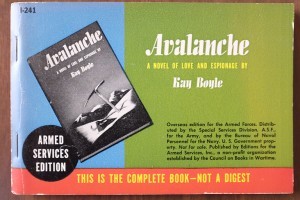


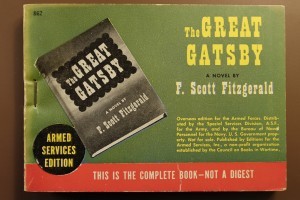

The first title in the series was The Education of Hyman Kaplan, a collection of humorous stories by Leo Rosten. The author received these words from a grateful serviceman:
I want to thank you profoundly, for myself and more important, for the men here in this godforsaken part of the globe. … Last week we received your book on Mr. Kaplan. … As an experiment, I read it one night at the campfire. The men howled. Now they demand I only read one Kaplan story a night: A ration on pleasure.
The volumes were designed and printed to be read and discarded. While paperback volumes date to the late 15th century, the Armed Services Editions were a harbinger of the postwar mass-market approach that revolutionized American book-buying and reading habits.
Author Wallace Stegner was proud that his work, The Big Rock Candy Mountain, was part of that first great experiment in the mass production and mass distribution of books. He added, The paperback revolution that followed owed an incalculable debt to the Armed Services Editions.
Author Irving Stone, whose works Lust for Life and Immortal Wife were included in the series, believed the book-distribution program to be one of the most significant accomplishments of our war effort. He recalled letters from soldiers who credited the project with their desire to read a book straight through for the first time in their lives.
Authors who served overseas took particular pride in the inclusion of their books. David Ewen (Men of Popular Music and The Story of George Gershwin), who served in the armed forces during World War II, said he knew only too well what a solace books could be.
I myself not then being too long a civilian remember my pride at seeing the small paper edition and thinking of it going out to beguile the time of soldiers and sailors, said novelist Herman Wouk about his work Aurora Dawn.
Serviceman Arnold Gates carried a copy of Carl Sandburgs Storm Over the Land in his helmet during the 1944 Battle of Saipan. During the lulls in the battle I would read what he wrote about another war and found a great deal of comfort and reassurance. Years later, Sandburg inscribed the book for him.
Author Kay Boyle learned from retired servicemen that her book Avalanche: A Novel of Love and Espionage was more or less required reading for them before they took part in missions over France.
Amid concerns about government distribution of titles that might favor the re-election of Franklin D. Roosevelt to a fourth term, Congress passed Title V of the Soldier Voting Act of 1944. The law banned some titles from being distributed to the armed forces. A temporary ban was placed on E. B. Whites One Mans Meat, though White recalled that the boys overseas told me that my essays about life in New England reminded them of home and made them feel good about what they were doing.
Distribution of 155,000 copies of F. Scott Fitzgeralds The Great Gatsby to the armed forces during World War II helped spur the novel to a level of success it had not achieved in the authors lifetime. To date, the book has sold more than 25 million copies.
The Great Gatsby endures because its our most American and our most un-American novel at once: telling us the American Dream is a mirage, but doing so in such gorgeous language that it makes that dream irresistible, says Maureen Corrigan, author of So We Read On: How the Great Gatsby Came to Be and Why It Endures.
How better to inspire the troops to victory?
Library of Congress's Blog
- Library of Congress's profile
- 74 followers



